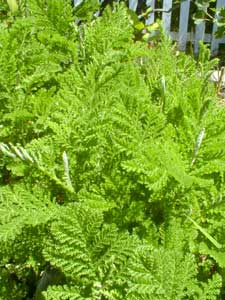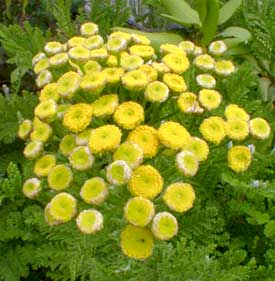
'Crispum' Ornamental Tansy;
aka, Curled Tansy;
aka, Fernleaf Golden Buttons
"He pipes the dead up from their grave,
Whose bones the tansy hides."
-John Albee
(1833-1915)
"In all sweet flowers that blow Lurks Death."
-Maybury Fleming,
flourished 1880s
(1833-1915)
flourished 1880s
The species Tanacetum vulgare is often distinguished from the variant 'Crispum' as Common Tansy or Wild Tansy, versus this more interesting Garden Tansy or Ornamental Tansy.
 Other common names for T. vulgar crispum include, for the leaves or the odor thereof: Parsley Fern, Scented Fern, Stinking Elshander (after the recluse in Sir Walter Scott's The Black Dwarf), Stinking Willie, or most whimsically, Cheese.
Other common names for T. vulgar crispum include, for the leaves or the odor thereof: Parsley Fern, Scented Fern, Stinking Elshander (after the recluse in Sir Walter Scott's The Black Dwarf), Stinking Willie, or most whimsically, Cheese.It was called Hindheal or Hindhead because of the belief that it could be placed in shoes to ward off foot ailments, or under pillows to get rid of bedbugs. Other names have included English Cost, Weebo, Traveller's Rest, Wild Quinine, or Tanacetum. 'Crispum' in particular is also distinguished as Fernleaf Golden Buttons, Double Tansy, or Curled Tansy.
Miniature chrysanthemum-like yellow flowers are long lasting in summer, with a final rebloom possible as late as October. These flowers have lent it such additional common names as Bachelor Buttons, Gold Buttons, Golden Buttons, Yellow Buttons, or because of the nasty flavor, Bitter Buttons or Ginger Plant.
This close relative of Feverfew has such fern-like foliage that it is especially to be recommended in a sunny, rarely watered xeriscape garden where a fern would be liked, but where actual ferns would die. It can spread aggressively, however, & should not be expected to play well with other pernnials of a similar size.
The flowers have a perfume that is not pleasing. It's not the sort of thing one plants near the door, & would be horrifying in a cut bouquet in the house. I initially had it planted in a morning sun-garden too near the porch as it turned out. I kept getting unwanted whiffs of the stuff. Partly because the odor was too near the door, & partly because it becones scruffy-looking in late autumn then turns black & horrid in winter, I dug it up & moved it to the streetside where it now grows way too happily in a harsh unwatered spot.
When I moved it, I noted that it had developed long fat soft roots. A scant month after it was moved to the street, I planted some allium bulbs near the tansy, & kept encountering those same long tansy roots which had grown like mad to restore what I had clipped off in the transplant.
'Crispum' is a little less aggressive than the species, which has an invasive root system. But even 'Crispum' will tend to get out of hand in locations it enjoys. Fortunately it is easily pulled up to discard unwanted excesses, because the thick white spreading roots are not deeply rooted. I periodically consider getting rid of it as I would most weeds, but for spring & summer it is just so attractive in a hot dry spot where nothing else would be likely to grow.
When after a long hot summer at long last makes it look tattery, it should be cut to the ground; this will likely be shortly after its major July/August bloom is finished. It will return fresh for autumn & probably bloom a second time, recovering from a sheering so quickly that it is in flower again by late August or in September. Even if it has no rebloom it will at least have the fernlike or mossy presence of its refreshed leaves, which will last until autumn's end, when it will have winter die-back.
It is not fussy as to soil conditions, so long as the ground drains well. It will not thrive in shade or wetness. Even moderate watering may make the flower stems floppy; ours thrives without being watered even at the droughty height of summer. Clumps divide readily in spring, or at any time during the growing season.
Originally from Europe, the species (rather than the curly variant) has naturalized in many areas of the United States, having been brought to North America in colonial times for its medicinal value in treating parasitic worms. Its medicinal use goes back to ancient Greece & Rome, & very likely to Stone Age Europe.
Despite that it is an insect repellant, it seems to be well liked by butterflies. It was a tradition among orchard farmers to plant it amidst the trees to discourage harmful insects without discouraging pollinators. In days before refrigeration, it was used as preservative wrapping for stored meats.
Formerly grown as a commercial crop providing volatile oils to be used for flavoring & in dubious health remedies, the thujone content made its use potentially unsafe. It was a medieval midwife "cure" for pregnancy since a sufficient dose can induce miscarriage.
Once popular as a tonic tea, the potential side-effect of death has placed it in lesser esteem nowadays. Steeped stems & leaves provided the traditional tonic, but overuse is sufficiently dangerous that at least one death has been ascribed to the use of tansy tea, & it more generally interfers with the efficacy of prescription drugs. It can be especially dangerous if ingested while taking anticoagulant medications, including aspirin.
So it is no longer well regarded for internal uses. Most of the quacky "herbal remedy" companies & misnomered "healthfood stores" when buttonholed by the law to justify their wild claims of various efficacies of all manner of stale plant particles, invariably admit they sell food supplements, not medicines, despite that so many advocates & vendors without even rudimentary medical knowledge (alternative or mainstream) have ready answers for each herb's purported healing power.
Herbs such as tansy which do indeed have powerful chemical components are not as likely to be offered for sale as are the more certainly worthless things, since tansy could very well put such hoodwinking vendors of quack remedies in the way of civil suits & prison sentences for injuring the health of users, if not for killing people. So instead of tansy, what you can get in healthfood stores nowadays is Feverfew (T. partheneum) which lacks the toxic thujone & though inconsequential as a curative is at least vastly more safely imbibed by the sorts of hypochondriacs who count on check-out tellers as their primary medical providers.
Tansy's active ingredients of camphor, borneol, & thujone give it its horrible taste & its capacity to ward off insects. New tender leaves are even so sometimes added to salads, with the warning that over use is harmful. The flowers in particular have a gingery taste, regarded as delicasies by some, while others find the flavor nasty.
When fully cooked, however, not only is toxicity neutralized, but the harsh edge of the flavor declines. It is a safe culinary spice so long as it is exposed to sufficient heat, such as in a hot frying pan, or baked in a custard or quiche. It can be dried for just such culinary uses, serving as a substitute for nutmeg, cinnamon, or ginger. A traditional Easter custard, no longer popular, was spiced with tansy & feverfew, in imitation of the Jewish Passover tradition of bitter herbs eaten as reminders of hardships in the wilderness.
Some garden-fresh herbs are a bit stressed at high summer & not as readily harvested for kitchen use (as in the case of Water Parsley too scruffy in summer for the table), or which get tougher in summer & less appetizing than they are in spring & autumn (as in the case of Salad Burnet). So it's nice to have tansy's July flowers for kitchen use. I have a very quick & easy way of using them.
As Granny Artemis & I are vegetarians, we sometimes have sausage-like "veggy patties" in the freezer. When I want to be healthy these just go in a toaster so as to require no frying in oil or butter, then I make a breakfast sandwich from the fat-free toastered patties. But when I'm feeling decadent, which is quite often, I fry them in butter. To gussy them up further, I trim a handful of yellow bachelor buttons from the tansy clump, & fry them in the same butter with the patties. Once the patties are good & fried & moved to a slice of bread, I poor the remaining tansied butter through a tea strainer onto a second bread slice & brush the butter thin. The fried buttons could themselves be eaten as part of the relish, but they are by then leached of flavor & I dislike the texture, so I use only the tansied butter & discard the fried buttons. A bit of lettuce growing near the back door for the purpose finishes off the hot sandwich. Tansied butter has a subtle flavor & none of the bitterness of the uncooked plant.
Tansy was also long used for embalming corpses & for funereal wreathes placed on the head of the dead, or hidden in the winding sheets to keep flies from attacking the corpse while it lay in state. Due to this grim association, tansy was rooted out of many New England gardens of the 19th Century as too mournful, even though it had formerly been one of the most essential & useful culinary & medicinal herbs grown in Colonial America.
The pungeant odor has long been associated with death. One might've guessed "Tansy" was a corruption of "Pansy" but the origin of the name is much more macabre than that. Even the Romans called it Tanacetum which means "Death," the name being pretty much the same as Thanatos, the Greek name of the land of the dead, or of a personification of Death. This was over the centuries corrupted into the modern English name Tansy, the French tanaisie, & the Spanish tanaceto, the plant essentially being called "Death plant" throughout Europe.